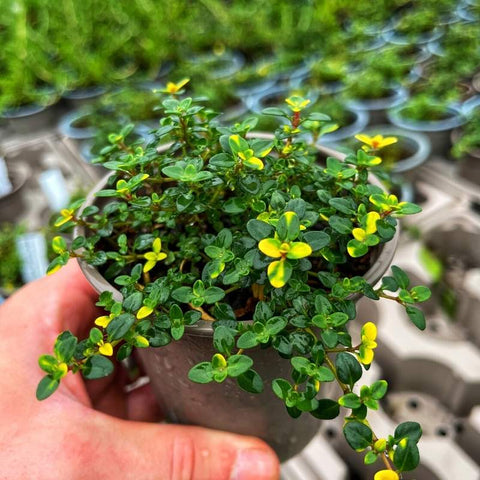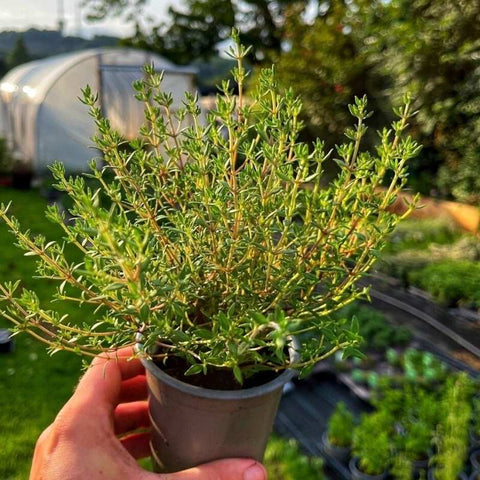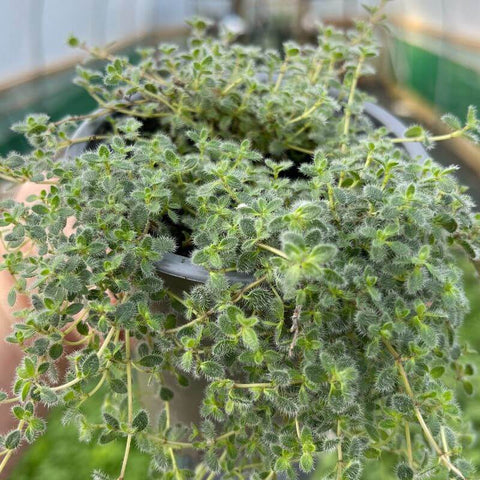How to grow thyme
Thyme (Thymus vulgaris), we almost feel like this herb doesn't need an introduction because it's so well-known and loved. However, this champion of the kitchen garden certainly deserves a full introduction, so we will indulge you. This flavourful herb with its tiny leaves and vast varieties is quite possible one of our favourites. Adding something magic to both sweet and savoury dishes, it's a must-have for any garden, whether you only have space for one special specimen, or ten, the rewards are endless. What's more, it's a really easy-to-grow plant, perfect for those new to growing, as well as a great gift for those with years and years of experience.

Where is best to plant thyme in the garden?
For starters, Thyme is a sun-loving herb that thrives in well-drained soil and basks in sunlight. When selecting the ideal spot for your thyme, you want to choose an area that receives at least six hours of direct sunlight daily if possible. This ensures robust growth and enhances the herb's aromatic oils, intensifying its flavour profile. However, it will tolerate some shade if you're not blessed with a sun trap growing space.
Well-draining soil is crucial to prevent waterlogged roots, a condition that thyme strongly dislikes. Thyme isn't particularly picky about soil pH, but slightly alkaline to neutral conditions are ideal and we'd certainly suggest giving it a fresh dousing of compost when first planted, as well as a good mulch once a year to keep it looking its best.
Whether you're planting thyme in the ground or in containers, space the plants approximately 12 to 18 inches apart. This allows for air circulation, reducing the risk of fungal diseases and promoting healthy growth. Whichever space you choose, this herb easily adapts to its e and produces huge amounts of foliage for you to cook and eat throughout the year.

How to grow thyme
Growing thyme from seeds can be a rewarding endeavor, allowing you to witness the herb's journey from germination to harvest but it can be a tricky process to get right, so most people start off with more establishes plants such as the ones we sell in 9cm pots. These are ideal for going directly out into the garden, whether you've got a permaculture herb spiral, a living wall or a space in one of your garden beds for this incredible plant. Once established, you can then take cuttings to spread the joy of herbs even further! Thyme cuttings root easily in well-draining soil, or in water, just make sure you don't take cuttings from the woody centre of the plant.
As your thyme matures, you want to make sure you're harvesting regularly as this promotes bushier growth and ensures a constant supply of fresh leaves for culinary use. Trim the stems just above a set of leaves not taking more than a third of the plant at any one time, and your thyme plant will reward you with a robust and aromatic display.

How to prune your thyme
Pruning is a vital aspect of thyme care, contributing to its compact form and enhancing both its visual appeal and flavor. Start by pinching back the tips regularly to encourage branching and prevent the plant from becoming leggy. This can double as your harvest, so definitely make use of your pinched tips for delicious desserts and hearty stews.
In early spring or late winter, a good, slightly harsher pruning is worthwhile to shape the plant and remove any dead or woody growth. Thyme can withstand a significant trim, just be careful not to cut into the woody growth as this will prevent it from growing back in certain areas.

How to care for your thyme in the winter
While thyme is generally hardy, providing some care in the winter months ensures its v and resilience come spring. Mulch around the base of thyme plants to insulate the roots and protect them from freezing temperatures. IF you're growing your thyme in pots, these can be moved indoors to shield it from the harsh winter elements. Place it near a sunny window, and your thyme will happily endure the winter chill. However, be careful to monitor its water levels as you don't want them to dry out whilst out of reach of rainfall.
To help you step into the wonderful world of thyme, here are a few of our favourite varieties that we really think you need to try:




